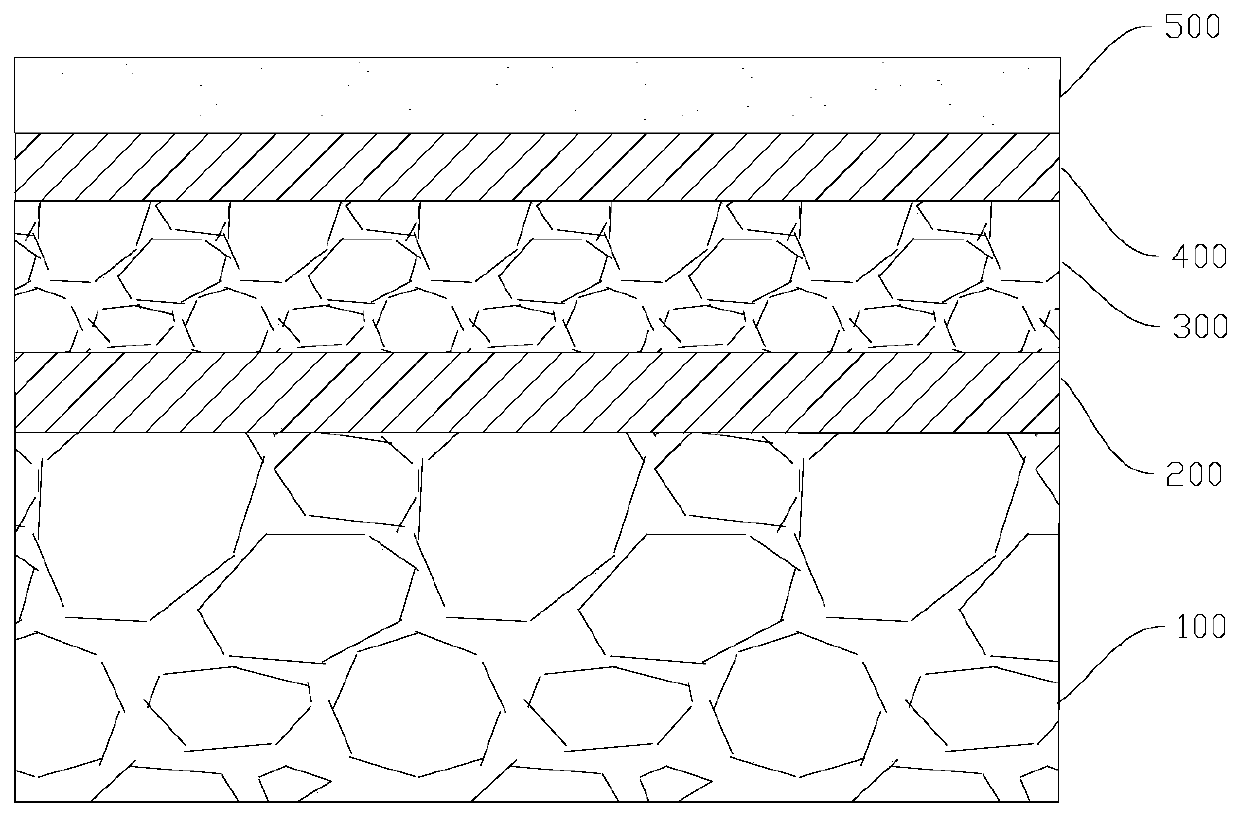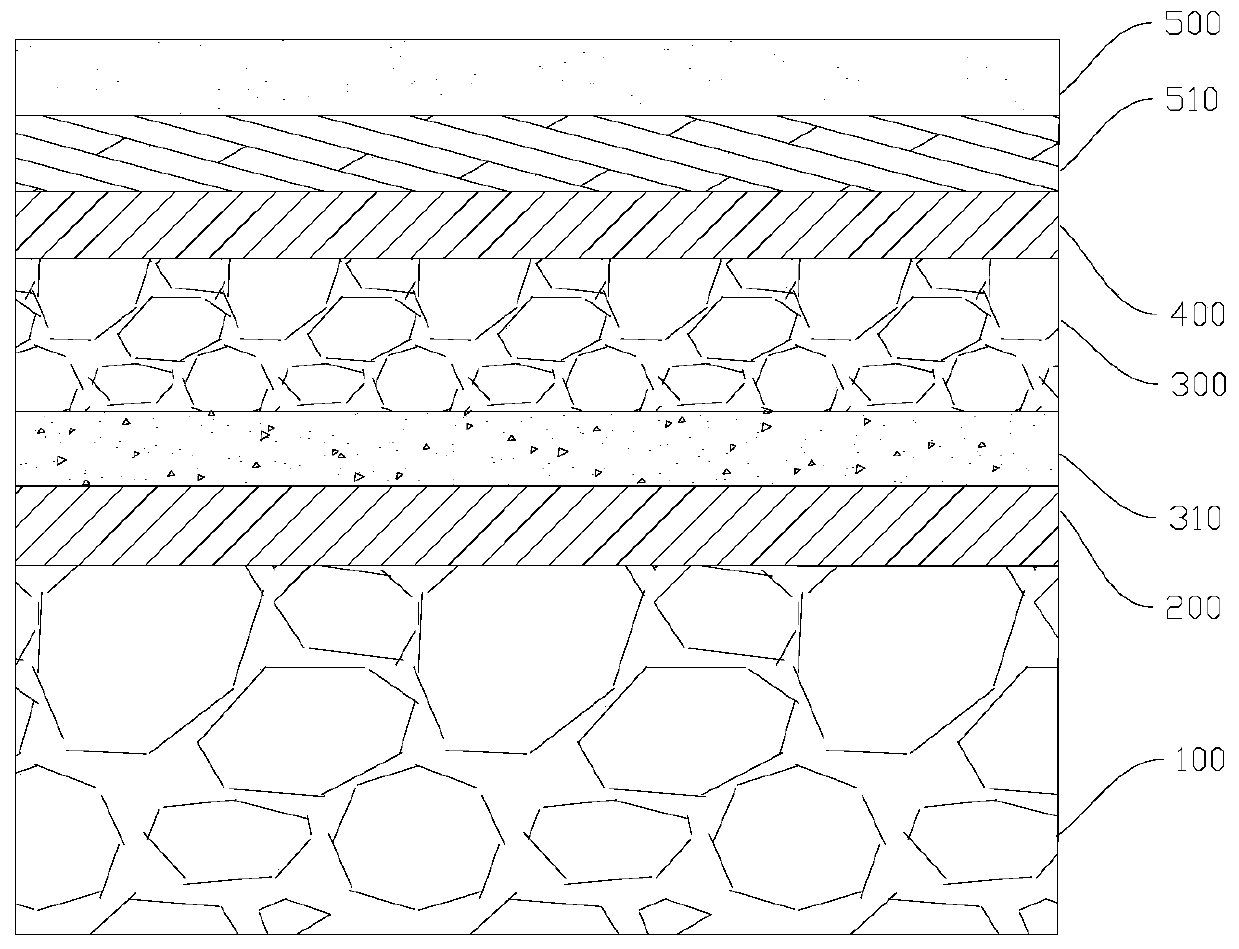Saline-alkali land restoration system and method
A technology for repairing systems and saline-alkali land, applied in the field of ecological restoration, can solve problems such as poor salt discharge effect, achieve the effects of reducing production costs, wide sources, and avoiding huge differences
- Summary
- Abstract
- Description
- Claims
- Application Information
AI Technical Summary
Problems solved by technology
Method used
Image
Examples
Embodiment 1
[0027] refer to figure 1 , to provide a saline-alkali land repair system, the saline-alkali land repair system is set on the saline-alkali land after leveling the land, and includes a rubble layer 100, a first geotextile layer 200, a gravel layer 300, a second geotextile layer 400 and Planting soil layer 500. The rubble layer 100 is formed by stacking rubble with a size (particle size) of 200mm-300mm, and the thickness is about 80cm. The first geotextile layer 200 is made of waterproof composite geotextile. This type of geotextile can form an effective package, has good performance of isolating leakage, high strength, corrosion resistance, durability, and low elongation. The crushed stone layer 300 is formed by stacking crushed stones with a size (particle size) of 20mm-30mm, and the thickness is about 50cm. The second geotextile layer 400 and the first geotextile layer 200 use the same geotextile. The planting soil layer 500 is made of a mixture of loess, humus and organic...
Embodiment 2
[0033] refer to figure 2 , to provide a saline-alkali land restoration system, the saline-alkali land restoration system is set on the saline-alkali land after leveling the land, and includes a rubble layer 100, a first geotextile layer 200, a litter layer 310, a gravel layer 300, a second Geotextile layer 400 , straw layer 510 and planting soil layer 500 . The selection and setting of the rubble layer 100 , the first geotextile layer 200 , the gravel layer 300 , the second geotextile layer 400 , and the planting soil layer 500 are the same as those in Embodiment 1. The litter layer 310 adopts the litter of plants such as ginkgo, larch, tulip tree, magnolia, eight-treasure tree, silver birch, and acacia to form the litter layer. The litter has very good water-holding performance. When the salt in the saline-alkali soil below the geotextile layer 200 returns to salt due to various reasons, the high water-holding litter layer 310 can ensure that the salt will not return to the...
Embodiment 3
[0035]A saline-alkali land restoration system, the difference from Embodiment 2 is that a drainage pipe is embedded in the straw layer, and the drainage pipe is connected to a salt discharge well. The setting of the drainage pipe can make the water flow generated during the precipitation be discharged to the salt drainage well in time, so as to avoid the migration of salt in the saline-alkali land due to flood irrigation during high rainfall.
PUM
| Property | Measurement | Unit |
|---|---|---|
| Particle size | aaaaa | aaaaa |
| Particle size | aaaaa | aaaaa |
| Thickness | aaaaa | aaaaa |
Abstract
Description
Claims
Application Information
 Login to View More
Login to View More - R&D
- Intellectual Property
- Life Sciences
- Materials
- Tech Scout
- Unparalleled Data Quality
- Higher Quality Content
- 60% Fewer Hallucinations
Browse by: Latest US Patents, China's latest patents, Technical Efficacy Thesaurus, Application Domain, Technology Topic, Popular Technical Reports.
© 2025 PatSnap. All rights reserved.Legal|Privacy policy|Modern Slavery Act Transparency Statement|Sitemap|About US| Contact US: help@patsnap.com


